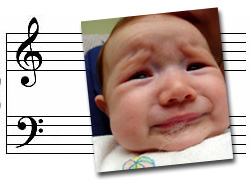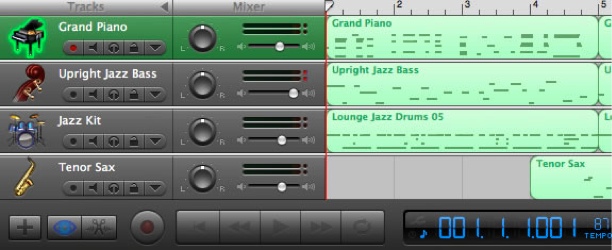 Greasy Lounge Lizard
Greasy Lounge Lizard
The marvels of GarageBand: music on
demand.
Here it is, an early seventies Lounge Lizard
special that I just put together using GarageBand. You may want to play it as
you are reading this
blog.
That's what we used to call 'em, greasy lounge lizards. Even after the dry look for men took over in the early 1970's, there were many lounge lizards. Guys with hair slicked back using hair tonic. Big toothed comb marks through the pompadour waves. Cigarette in one hand, mixed drink in the other. Always had their eye on some chick. Seldom scored. Usually married. And in the background was the ever present old standard, a slow, romantic ballad played in jazz style by a band of guys, some of whom were themselves greasy lounge lizards. I used to play piano with some of these bands. I could literally walk into a room with two or three other musicians that I had never met, play these standards for three hours, and walk out with cash in my hand. The ideal was a quartet: piano, base, drums and tenor sax.
 So when I bought Mac's iLife '06 the other day and installed it on my computer,
I decided it was finally time to see what the program GarageBand was all about.
It has gone through five upgrades since I last looked at it in 2003. I started
up the program. I dug out the still unused $99 Keystation 49 midi keyboard and
plugged it in to the USB jack. What you see in GarageBand is the controls of a
music studio.
So when I bought Mac's iLife '06 the other day and installed it on my computer,
I decided it was finally time to see what the program GarageBand was all about.
It has gone through five upgrades since I last looked at it in 2003. I started
up the program. I dug out the still unused $99 Keystation 49 midi keyboard and
plugged it in to the USB jack. What you see in GarageBand is the controls of a
music studio.
For some reason, when I saw this intriguing blank slate, I remembered one very popular tune from my lounge lizard era, "That's All," words & music by Alan Brandt & Bob Haymes, 1953, recorded by Frank Sinatra in 1962. Since I already had the music in my head, it was just a matter of figuring out how to get it into the computer. I added tracks for the four instruments in my software quartet. GarageBand lets you drag 4 measures at at time of rhythm from hundreds of various "drum kits." I chose Lounge Jazz Drums 3, 4, and 5. For the other tracks I selected Tenor Sax, Grand Acoustic Piano, and Upright Jazz Base. First I recorded the intro, and then I recorded 8 bar sections of the piece.
My strategy was to lay down the drum track for rhythm, then put down the base, then the tenor sax, and finally the piano. In each case what you do (except for the drums, which are canned) is to click on the track of the instrument you want to record, start recording after an introductory measure of beats, and then play the melody on the midi keyboard in synch with the drum sound and beat that is emerging. You actually hear the instrument you have chosen as you play the keyboard. It's that simple. Well—it isn't actually THAT simple. I had a hard time keeping from speeding up. The resulting music, which you can hear by clicking on the embedded mp3 at the top of this file, actually sounds like an unpracticed, unpolished, very mediocre lounge band from the period. BUT, you can hear that with the right amount of practice and talent, and in the right hands, this could produce some amazing stuff.
Now where are those chicks??!!
That's what we used to call 'em, greasy lounge lizards. Even after the dry look for men took over in the early 1970's, there were many lounge lizards. Guys with hair slicked back using hair tonic. Big toothed comb marks through the pompadour waves. Cigarette in one hand, mixed drink in the other. Always had their eye on some chick. Seldom scored. Usually married. And in the background was the ever present old standard, a slow, romantic ballad played in jazz style by a band of guys, some of whom were themselves greasy lounge lizards. I used to play piano with some of these bands. I could literally walk into a room with two or three other musicians that I had never met, play these standards for three hours, and walk out with cash in my hand. The ideal was a quartet: piano, base, drums and tenor sax.
 So when I bought Mac's iLife '06 the other day and installed it on my computer,
I decided it was finally time to see what the program GarageBand was all about.
It has gone through five upgrades since I last looked at it in 2003. I started
up the program. I dug out the still unused $99 Keystation 49 midi keyboard and
plugged it in to the USB jack. What you see in GarageBand is the controls of a
music studio.
So when I bought Mac's iLife '06 the other day and installed it on my computer,
I decided it was finally time to see what the program GarageBand was all about.
It has gone through five upgrades since I last looked at it in 2003. I started
up the program. I dug out the still unused $99 Keystation 49 midi keyboard and
plugged it in to the USB jack. What you see in GarageBand is the controls of a
music studio. For some reason, when I saw this intriguing blank slate, I remembered one very popular tune from my lounge lizard era, "That's All," words & music by Alan Brandt & Bob Haymes, 1953, recorded by Frank Sinatra in 1962. Since I already had the music in my head, it was just a matter of figuring out how to get it into the computer. I added tracks for the four instruments in my software quartet. GarageBand lets you drag 4 measures at at time of rhythm from hundreds of various "drum kits." I chose Lounge Jazz Drums 3, 4, and 5. For the other tracks I selected Tenor Sax, Grand Acoustic Piano, and Upright Jazz Base. First I recorded the intro, and then I recorded 8 bar sections of the piece.
My strategy was to lay down the drum track for rhythm, then put down the base, then the tenor sax, and finally the piano. In each case what you do (except for the drums, which are canned) is to click on the track of the instrument you want to record, start recording after an introductory measure of beats, and then play the melody on the midi keyboard in synch with the drum sound and beat that is emerging. You actually hear the instrument you have chosen as you play the keyboard. It's that simple. Well—it isn't actually THAT simple. I had a hard time keeping from speeding up. The resulting music, which you can hear by clicking on the embedded mp3 at the top of this file, actually sounds like an unpracticed, unpolished, very mediocre lounge band from the period. BUT, you can hear that with the right amount of practice and talent, and in the right hands, this could produce some amazing stuff.
Now where are those chicks??!!
Posted: Thu - February 23, 2006 at 04:00 PM
Quick Links
Profile (Sort Of)
Month's Priorities
Categories
Blogs/Sites I've Been Reading
Learning To Step Lightly, Alexah Strongheart
The Brain Science Podcast, Dr. Ginger Campbell
Arianna Huffington at the Huffington Post
The Brain Science Podcast, Dr. Ginger Campbell
Arianna Huffington at the Huffington Post
My Websites
About Jim Andris
Jim Andris' Personal Website
Jim Andris' Genealogy
Jim Andris' Facebook
Jim Andris, Musician, Facebook
Jim Andris' Shelfari
The Far Outpost
Jim Andris' Virtual Tourist Page
Jim Andris' Personal Website
Jim Andris' Genealogy
Jim Andris' Facebook
Jim Andris, Musician, Facebook
Jim Andris' Shelfari
The Far Outpost
Jim Andris' Virtual Tourist Page
Other Media We Watch
Calendar
| Sun | Mon | Tue | Wed | Thu | Fri | Sat |
XML/RSS Feed
Archives
Statistics
Total entries in this blog:
Total entries in this category:
Published On: Mar 18, 2009 10:50 AM
Total entries in this category:
Published On: Mar 18, 2009 10:50 AM
